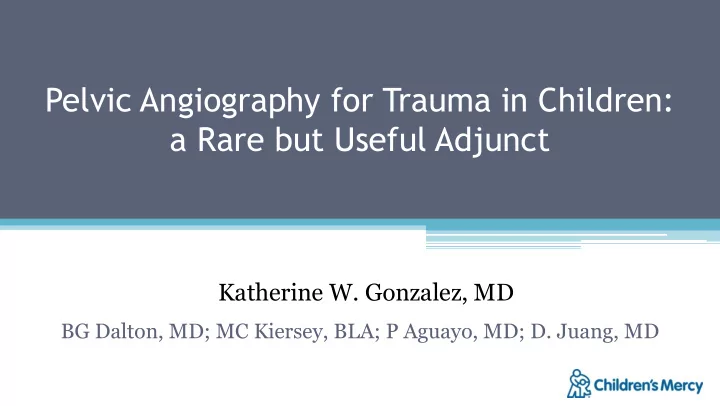

Pelvic Angiography for Trauma in Children: a Rare but Useful Adjunct Katherine W. Gonzalez, MD BG Dalton, MD; MC Kiersey, BLA; P Aguayo, MD; D. Juang, MD
We have no conflicts of interest to disclose.
Background • External Compression • Rare but real threat of pelvic fractures • Angiography • Pelvic packing • Direct vessel ligation
Background • EAST Guidelines 2011 • 85-100% success rates
Methods • Retrospective review • Level 1 Trauma • 2004-2014
Results Total patients with pelvic fractures n=249 Transferred to adult facility n=2 Discharged home n=31 Included patients with pelvic fractures n=216
Mechanism of Injury Motor vehicle collision Fall All terrain vehicle 61% Automobile vs pedestrian UGI Animal Other (abuse, gun shot, sports injury, TV)
Distribution of Pelvic Fractures 160 140 120 100 80 60 40 20 0 Superior Inferior Iliac wing Sacrum Acetabulum Ischium Open book rami rami
• 28 patients (13%) had operative treatment of pelvic fractures External fixation Open reduction internal fixation Spica • No preperitoneal packing
Gelfoam • Four patients (1.9%) underwent angiography Extravasation All four had clinical evidence of hemorrhage Coiling One had contrast extravasation on imaging Angiography No further No extravasation intervention *No incidence of pseudoaneurysm, femoral artery thrombosis or end organ necrosis.
Contrast extravasation on CT scan? Three patients Stabilized in the ICU 2/3 concurrent injuries 2/3 blood transfusion but responded 2/3 OR the following day for pelvic repair
Conclusion • Angiography appears to be a safe therapy in children. • Reserve for those with ongoing blood loss. • Despite extravasation, consider stability of the patient first, as angiography may not be necessary.
Future Direction • Need for a standard treatment algorithm for severe pelvic fractures • Consider a protocol based on the management of pediatric liver and splenic trauma.
Recommend
More recommend